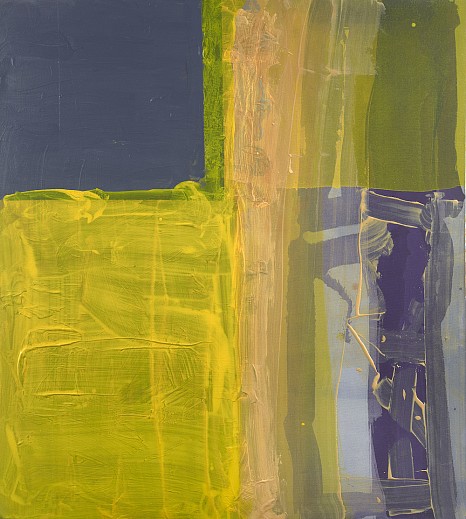
The Pure Vision of Frank Wimberley
June 26, 2019 - Franklin Hill Perrell for Hamptons Art Hub
From the moment I walked into the solo show “Frank Wimberley” at Berry Campbell in Chelsea, I became thoroughly engaged with Wimberley’s textural paintings. The works convey an exhilarating sense of freedom as well as a consistent vision: one major painting after another, evidencing some of the most original and varied paint handling I’ve seen.
On view through July 3, 2019, “Frank Wimberley” is a near survey and presents 20 paintings that roam across the decades (including recent works). Now 92 years old, Wimberley proves that he is still vibrant and active as an artist. He evolved as a pure painter, largely eschewing overt sociopolitical themes in his work and became exemplary of American abstraction’s mainstream; an expressionist responding to free association and guided solely by his own taste and intuition.
Wimberley benefited from both parents’ artistic encouragement: his father introduced him to music, and his mother, a ceramicist, to art. After two years at Howard University, Wimberley decided to teach himself. The example of Peter Voulkos showed him how an artist could cross over into many media.
In the early years of his marriage, Wimberley worked nights in the post office to be able to paint daytime. With his wife, Juanita, in 1960 he bought land and built their mid-century modern house in Sag Harbor, the surroundings of which, and links to the East End art community, created a positive atmosphere for his art. Wimberley continues to paint there as well as in his city studio in Queens.
Frank Wimberley has long-lived, part-time, in the Eastville neighborhood of Sag Harbor, N.Y., an established African American community of artists, writers, musicians, cultural figures and educators, located in The Hamptons. He figured strongly in the black arts movement of the 1970s, and is represented in many museum collections. He was also collected by a host of Jazz musicians like Miles Davis.
The marine ambience of Sag Harbor, with its characteristic Long Island light glancing off generous bays, infuses the artist’s aesthetic. Wimberley’s innate taste, lifelong studio practice, and superb technical knowledge, along with a keen sense of knowing when to conclude a painting, converges to produce this significant body of quite elegant works.
The paintings on view have a tactile richness arising from layered collage techniques, and extensive, often transparent, overpainting. Painted surfaces evoke the contrasting matte and reflective qualities of ceramic. The range of color is tight, but at times strident. Subliminal images peeking out from overpainting, a particular kind of pentimenti, are a Wimberley hallmark. Altogether abstract, painterly and gestural, the paintings nonetheless evoke associations of sand, sea, and sky because of their qualities of light, space and color.
Frank Wimberley really is a classic, and utterly original. A Wimberley painting looks like that of no one else but Wimberley.
The paintings in the front gallery demonstrate Wimberley’s fondness for color. Tangerine, 2001, features saturated color, its brilliant tint of semi-transparent orange painted over hues of deep red. In contrast, Untitled, 2010, overlays velvety tones of dark black and purple with bright yellow, salmon, and pale green. Above the reception desk is a magisterial tondo, Sphere (Thelonius), 2012, in silvery greys, grey blue and black.
Wimberley’s paintings often evidence the use of roplex (which sometimes goes by other names), a translucent binder and carrier for acrylic pigment that’s comparable to linseed oil for oil paint. A hallmark of Greenbergian formalism (as in late works by Poons and Olitski), Wimberley makes his own good use of this medium.
He handles paint in a wide range of unconventional ways, using scrapers, spatulas, and brushes of varying stiffness, width and type, to produce different effects. Wimberley’s link to ceramic art, with its glazes, sandy textures, and contrasting matte or glossy surfaces, is inescapable.
The artist embraces a freely additive process, often re-purposing elements from other canvases, as compositions are at times built by fascinating accretions, which carry their own history. This is particularly true of two canvases along the gallery’s longest wall.
Blue Patch, 1998, is a subtle beauty, almost ethereal: it is comprised of several swatches of canvas, smaller rectangles, some straight, others ragged edged, glued together into a strong unified composition. Column, 1996, which takes its name from a central vertical swath of red, enlivened further by a delicate calligraphic gesture in subtle black, is similarly comprised of collaged elements, several of which together form a horizontal band that becomes a painting within a painting.
Located in the middle gallery, Sandbar, 1995, is a quintessential beach painting, conjuring up sand and sky out of painterly abstract brushstrokes. Its soft palette of sun-drenched sandy colors with just a hint of pink, combines with surface textures to evoke sea-shore space and light.
The vanguard practice of automatism, a key element both with Abstract Expressionism and Surrealism, becomes, for Wimberley, a type of personal free association akin to jazz, very musical in spirit with theme and variations.
Soft Rain, 1995, is richly improvisatory, with an array of complex painterly incident, at times quite delicate, incised into the prevailing areas of black. It would be hard to find a more obvious example of kinship with jazz music than in this painting.
The innermost gallery room features the three most recent paintings: the quite delightful, upbeat Geranium, 2017, and Cudgel Falling, 2018, with its lively silvery white sea, collaged black sky, and vivid orange painted wedge that gives this painting its title, and the positively joyous Lady Day 2018, whose tints of green and blue filter through gesturally brushed white overpainting.
“Frank Wimberley” is a dramatic show: the paintings emphasize a square format in different sizes, tight yet lively compositions establishing a powerful visual rhythm and pervasive ascendant light. A happy convergence between well curated groupings yields positive surprises at every turn.
Wimberley’s art is classic abstract expressionist painting, pure, forthright, and straightforward. It’s an exhibition that visitors are bound to enjoy.
Back to News
